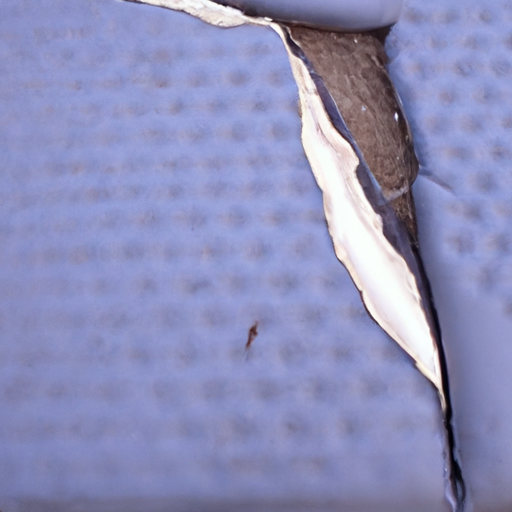So you’ve found yourself with a pesky hole in your air mattress, and now you’re left pondering the best way to fix it. Well, fear not, because we’re here to help! In this article, we’ll walk you through the steps on how to patch a hole in an air mattress, providing you with the knowledge and tools you need to get that mattress back in working order. Whether you’re camping in the great outdoors or simply need a temporary fix at home, we’ve got you covered. Let’s dive in and patch up that leaky air mattress!
Review contents
Identify the hole
Inspect the mattress surface
The first step in patching a hole in an air mattress is to identify where the hole is located. Start by examining the surface of the mattress carefully. Look for any visible signs of damage, such as punctures or tears. Take your time to thoroughly inspect the entire mattress, as sometimes the hole may be small and not immediately noticeable.
Listen for hissing sound
If you’re having trouble locating the hole visually, you can also try listening for a hissing sound. Inflate the mattress fully and press your ear close to the surface. Move your ear around different areas of the mattress to see if you can detect any air escaping. The sound of a quiet hiss can indicate the presence of a hole, helping you pinpoint its location.
Apply soapy water
Another effective method to detect a leak is by applying soapy water to the surface of the mattress. Mix a small amount of dish soap with water and use a sponge or cloth to apply the soapy solution over the mattress. Be thorough in your application, ensuring you cover the entire surface. Look for any visible bubbles or areas where the solution starts to form suds, as this indicates the presence of a hole. Make note of the location for repair.
Prepare the necessary materials
Gather the tools
Once you have identified the hole, gather the necessary materials to patch your air mattress. Some common tools you may need include a patching material, adhesive, scissors, a cloth, and soapy water. Ensure you have everything conveniently located, making the patching process smoother.
Choose the right patching material
When it comes to patching an air mattress, it’s essential to choose the right material to ensure a successful repair. Look for a patching kit specifically designed for air mattresses, as these often come with durable materials that can withstand the pressure and demands of inflation and use. Alternatively, you can also consider using a bike repair kit or self-adhesive patch kit as suitable alternatives.
Prepare the adhesive
In addition to patching material, you’ll also need adhesive to secure the patch to the mattress. Follow the instructions provided with your patching kit to prepare the adhesive. This may involve mixing different components or allowing the adhesive to set for a specific amount of time. Ensure you have the adhesive prepared and ready to use before moving on to the next steps.
Clean and dry the area
Remove any dirt or debris
Before applying the adhesive and patch, it’s crucial to clean the area around the hole thoroughly. Take a clean cloth or sponge and gently wipe away any dirt, debris, or dust from the surface. This step ensures that the adhesive can bond properly to the mattress and that no foreign particles interfere with the patching process.
Use a cloth to dry the area
After cleaning the area, it’s essential to dry it thoroughly. Use a dry cloth to absorb any moisture or liquid that may be present. Remember that a dry surface is crucial for the adhesive to adhere to the mattress properly. Take your time to ensure the area is completely dry before proceeding to the next steps.
Apply adhesive
Apply a thin layer of adhesive
With the area clean and dry, it’s time to apply the adhesive. Take a small amount of the prepared adhesive and carefully apply it to the surface around the hole. Make sure to use a thin layer, spreading the adhesive evenly to ensure proper adhesion. Be mindful not to use too much adhesive, as this can create a mess and make the patching process more challenging.
Spread the adhesive evenly
After applying the adhesive, use a spatula or any other suitable tool to spread it evenly over the entire area. This ensures that the adhesive covers the entire surface that the patch will be applied to, maximizing its effectiveness. Smooth out any excess adhesive and ensure that it is evenly distributed to create a secure bond between the patch and the mattress.
Allow the adhesive to dry
Once the adhesive is spread evenly, allow it to dry. Follow the instructions provided with your specific adhesive, as drying times may vary. During this drying period, it’s important to avoid inflating the mattress or applying any pressure to the patch area. Allowing the adhesive ample time to dry will ensure a strong and long-lasting bond.
Attach the patch
Place the patch over the hole
After the adhesive has dried, it’s time to attach the patch to the mattress. Take the patching material you have chosen and carefully position it over the hole. Ensure that the patch fully covers the damaged area, providing a secure and reliable seal.
Apply pressure to ensure adhesion
Once the patch is in place, apply pressure to help it adhere to the surface of the mattress. You can use your hands or a small roller to press down on the patch firmly. Make sure to apply pressure evenly over the entire surface of the patch to guarantee a strong bond with the mattress.
Smooth out any wrinkles
While ensuring the patch adheres properly, take the time to smooth out any wrinkles or bubbles that may have formed during the application process. These imperfections can compromise the effectiveness of the patch and potentially lead to future leaks. Smooth the patch carefully, ensuring it lies flat against the mattress without any creases or unevenness.
Leave it to set
Allow the patch to set for recommended time
After attaching the patch and removing any wrinkles, it’s important to let it set for the recommended amount of time. This typically ranges from a few hours to overnight, depending on the specific adhesive and patching material used. Avoid using or inflating the mattress during this period to allow the patch to fully bond and create a reliable seal.
Avoid inflating mattress during this period
While waiting for the patch to set, resist the temptation to inflate the mattress to check if the repair was successful. Inflating the mattress too soon can disrupt the bonding process and potentially compromise the effectiveness of the patch. Patience is key here, as allowing the patch enough time to set will ensure a more durable and robust repair.
Test the patch
Inflate the air mattress
Once the patch has set according to the manufacturer’s instructions, it’s time to put it to the test. Inflate the air mattress fully, ensuring that there is enough air pressure to simulate its regular use. Inflating the mattress will help you assess the patch’s effectiveness and whether any additional repairs or adjustments may be necessary.
Submerge the patched area in water
To test the patch thoroughly, submerge the patched area in water. Fill a basin or bathtub with water and carefully place the patched portion of the mattress into the water, ensuring it is completely submerged. Observe the patched area closely for any signs of air bubbles or leaks.
Check for any bubbles or leaks
While the mattress is submerged, carefully inspect the patched area for any bubbles or leaks. Pay close attention to the edges of the patch and any previously damaged sections. If you notice any bubbles or air escaping, it indicates that the patch may not have been successful. In this case, you may need to repeat the patching process or consider alternative repair methods.
Alternative patching methods
Using a bicycle repair kit
If you don’t have a dedicated air mattress patching kit on hand, a bicycle repair kit can often serve as a suitable alternative. These kits typically include patches and adhesive that are designed to withstand the demands of road use, making them a viable option for air mattress repairs. Follow the instructions included in the bicycle repair kit to successfully patch your air mattress.
Using duct tape as a temporary fix
In situations where an immediate repair is needed or when traditional patching materials are not available, duct tape can serve as a temporary fix for small holes in an air mattress. Strictly temporary, this method may not provide a long-term solution, but it can offer a quick fix in emergencies. Simply apply a piece of duct tape over the hole, ensuring it covers the damaged area completely.
Using a self-adhesive patch kit
Another alternative to consider is a self-adhesive patch kit. These kits often come with pre-cut patches that have an adhesive backing, eliminating the need for additional adhesive. Self-adhesive patches can provide a quick and convenient solution for smaller holes or tears in an air mattress. Follow the instructions provided with the patch kit for the best results.
Preventive measures
Avoid sharp objects near the mattress
To prevent future holes or damage to your air mattress, it’s important to be mindful of sharp objects in its vicinity. Keep the mattress away from any potential hazards, such as sharp furniture corners or pets with long claws. By taking precautionary measures, you can minimize the risk of accidental damage to your air mattress.
Use a protective cover
Using a protective cover for your air mattress can add an extra layer of defense against potential holes or tears. Opt for a cover made from durable materials that can withstand regular use and offer protection against common sources of damage. A cover can also help keep your mattress clean and free from dust or dirt.
Properly store and transport the mattress
When not in use, store your air mattress in a safe and secure location. Ensure it is kept away from sharp objects or anything that could potentially puncture it. During transportation, take extra care to avoid rough handling or placing heavy objects on top of the mattress. Proper storage and transportation practices go a long way in preserving the integrity of your air mattress.
When to consider buying a new air mattress
Multiple or large holes
While patching can be an effective solution, there may come a time when the number or size of holes in your air mattress makes it impractical to repair. If your mattress has multiple or large holes that cannot be adequately patched, it may be more cost-effective and efficient to invest in a new air mattress.
Deformation of mattress
If your air mattress has become significantly deformed and no longer provides a comfortable and stable sleeping surface despite successful patching attempts, it may be time to consider purchasing a new one. Over time, constant use and wear can cause irreversible damage to the internal structure of the mattress, leading to deformations that cannot be easily repaired.
Unsuccessful patching attempts
If you have attempted multiple patching methods but still find that your air mattress continues to leak or develop new holes, it may be a sign that the mattress has reached the end of its lifespan. While patching can resolve smaller issues, repeated unsuccessful attempts at repair suggest that the mattress is no longer capable of maintaining a reliable seal. In such cases, investing in a new air mattress is the best course of action.
By following these steps for patching and implementing preventive measures, you can successfully repair small holes in your air mattress and extend its lifespan. Remember to be thorough in your inspection, choose the right materials, and allow for proper drying time to ensure a strong and reliable patch. With the right approach and a bit of patience, you can continue to enjoy the comfort and convenience of your air mattress for years to come.
























